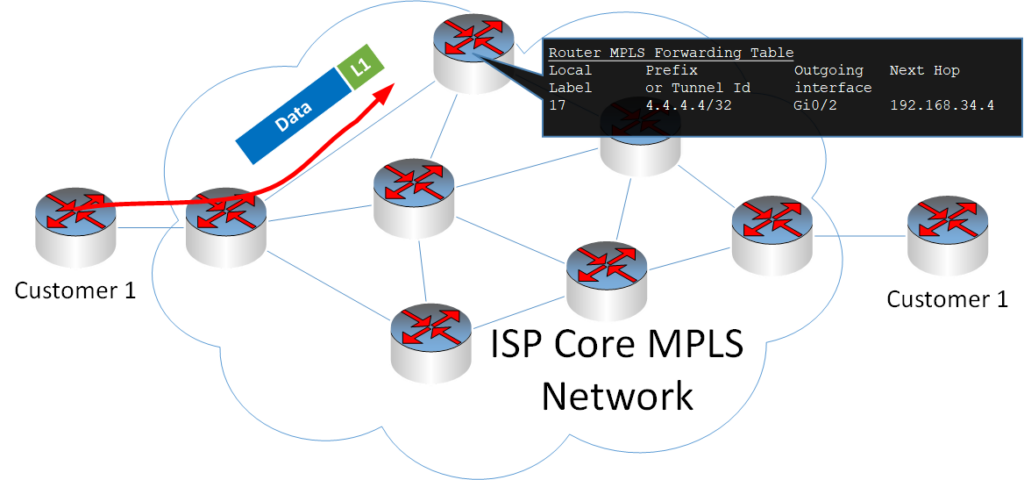Multi-Protocol Label Switching is a high-performance network technology designed to efficiently direct data across a network. Unlike traditional IP routing, which relies on destination addresses, this technology uses labels to determine the best path for data packets. This approach enhances speed and efficiency, particularly in large-scale ISP networks and geographically dispersed infrastructures.
Many networking professionals find it challenging at first due to its differences from conventional routing and switching technologies. However, understanding its fundamentals can reveal its advantages over traditional networking methods. This guide provides a clear explanation of this technology, its purpose, and its benefits.
What is MPLS?
MPLS is designed to improve data transmission efficiency between nodes. It is primarily found within the core networks of ISPs and large organizations that manage extensive geographical connectivity.
Unlike traditional routing, which relies on IP addresses, it assigns labels to packets, enabling a pre-determined path between endpoints. This mechanism allows the technology to encapsulate various network protocols, including:
- IPv4
- IPv6
- Ethernet
- ATM
- Frame Relay
- T1/E1 lines
- DSL
Due to its versatility, it is often considered a tunneling protocol, though the term “tunnel” is not frequently associated with it. Instead, it serves as an underlay network capable of transporting multiple payload types while supporting diverse overlay technologies.
MPLS as a “Layer 2.5” Protocol
MPLS operates in a unique space between the Data Link Layer (Layer 2) and the Network Layer (Layer 3) of the OSI model. This intermediate function earns it the designation of a “Layer 2.5” protocol.
When an MPLS header is appended to a packet, it is inserted between the Layer 2 and Layer 3 headers. This placement enables it to optimize packet forwarding while maintaining compatibility with traditional networking technologies.
What is the Purpose of MPLS?
MPLS is primarily used in large-scale networks, particularly within ISP infrastructures. It is not typically deployed in small or medium-sized enterprises unless they own a WAN infrastructure.
The primary function of MPLS is to interconnect multiple remote sites. ISPs use this technology to:
- Provide secure and efficient traffic separation for multiple customers.
- Enable customers to leverage a shared MPLS infrastructure while maintaining isolated network traffic.
MPLS and Last-Mile Connectivity
It is important to note that it is not a last-mile technology. It does not provide WAN access in the same way that fiber, DSL, or cable connections do. Instead, it can be deployed over these last-mile technologies to establish a broader network infrastructure.
For example, an ISP might use a fiber connection, DSL, or wireless microwave link to deliver connectivity to this network. However, this technology itself is not involved in that last-mile delivery process.
Benefits of MPLS
Given the choice between MPLS and traditional IP routing, why would an organization opt for MPLS? The key advantages lie in its efficiency and performance.
Increased Routing Efficiency
In traditional IP routing, routers determine packet destinations by scanning extensive routing tables. This process requires each router in the network to:
- Examine the packet’s destination IP address.
- Compare it against thousands of routing table entries.
- Determine the exit interface for forwarding the packet.
- Repeat the process at each subsequent node until the packet reaches its destination.
This method can be highly CPU-intensive, particularly in high-capacity networks serving thousands of customers.

Label Switching Operation
MPLS improves upon traditional routing by using label switching instead of IP lookups. The process works as follows:
- When an IP packet arrives at the first router in the MPLS network, it is assigned a label based on the customer or traffic type.
- The packet is prepended with an MPLS header containing the assigned label.
- Intermediate routers in the MPLS network examine only the label (rather than the full IP header) to make forwarding decisions.
- The label is swapped at each hop, directing the packet through the network efficiently.
- When the packet reaches the final router at the network edge, the MPLS label is removed, and the packet is forwarded based on its original IP header.
By using fixed-length labels instead of full IP address lookups, MPLS reduces the complexity of packet forwarding, leading to improved network performance and efficiency.
Advantages of Using Labels
One of the primary benefits of MPLS is its ability to streamline packet forwarding through the use of labels. Key advantages include:
- Reduced Processing Overhead: Routers do not need to scan extensive routing tables at every hop, reducing CPU and memory requirements.
- Predictable Paths: Once an MPLS path is established, packets with the same label typically follow the same route. This contrasts with traditional IP routing, where packets may take different paths depending on real-time routing decisions.
- Improved Network Performance: MPLS allows ISPs to manage high-volume traffic with greater efficiency, ensuring consistent performance for customers.
Summary
MPLS enhances data forwarding efficiency by using labels instead of traditional IP address lookups. It is primarily deployed in large ISP networks and is designed to interconnect remote sites while maintaining secure and efficient traffic separation.
Unlike conventional IP routing, this technology provides a more efficient way to move data through a network by reducing processing overhead at each node. Through label switching, it simplifies routing decisions, improves performance, and ensures a predictable data path.
For large-scale network infrastructures requiring high efficiency, this technology remains a preferred solution, providing scalability, security, and superior traffic management capabilities.
Also read: Why does BGP require an IGP to function?
About:
Welcome to telecomTech, where telecom and networking technologies… are simply explained! I’m Lazarus, a telecom professional with over 25 years of experience in network design, architecture, and telecom technologies. Over my career, I’ve led major projects, trained professionals, and helped countless individuals earn certifications and advance their careers.
My goal is to make networking and telecom concepts clear, practical, and engaging—the way I wish they were taught when I started learning!
Whether you’re a student, a professional growing your skills, or preparing for certifications like Cisco, telecomTech is here to guide you.
Join me as we explore telecom and networking as a lifelong passion, not just a job. Let’s make this journey of growth and discovery together!


MPLS technology streamlines data transmission by using labels instead of traditional IP addresses, improving efficiency in large networks. Its unique function between the Data Link and Network Layers highlights its adaptability and performance. Understanding MPLS can help networking professionals optimize their infrastructure for better reliability and speed. How does MPLS enhance the scalability of ISP networks compared to traditional routing methods?
Great summary of MPLS! One key way MPLS enhances ISP scalability is by allowing more flexible and efficient traffic engineering, making better use of available bandwidth. It also reduces the size of routing tables in the core by using label switching instead of full IP lookups at every hop. This makes it easier for ISPs to grow and manage large, complex networks.